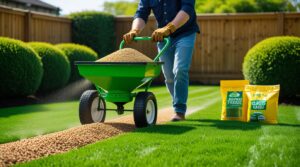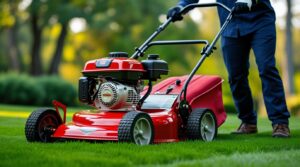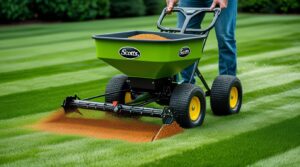A lush, envy-worthy lawn isn’t just about watering and wishing for the best—it’s about precision. And one of the simplest tools to take your lawn from patchy to picture-perfect is the humble lawn spreader.
Whether you’re applying fertilizer, grass seed, or weed control, a lawn spreader ensures even, accurate distribution across your yard. That means no more clumps, bare spots, or wasted product. It’s a must-have for homeowners who care about curb appeal and want to save time (and money) on lawn care.
If you’re new to the world of spreaders or just not sure which one is right for your needs, don’t worry—this guide has you covered. We’ll break down the different types of lawn spreaders, review the top models, explain how to use them like a pro, and answer the most common questions people search online.
What Is a Lawn Spreader and Why Do You Need One
A lawn spreader is a simple yet powerful tool designed to evenly distribute materials like fertilizer, grass seed, lime, compost, or even ice melt across your yard. Instead of pouring by hand and risking clumps or missed patches, a lawn spreader helps you apply products consistently, ensuring your lawn gets the exact nutrients it needs in all the right places.
Without a spreader, it’s easy to over-treat one area and under-treat another. This can lead to uneven growth, wasted product, or even damage to your grass. With a lawn spreader, every pass delivers controlled, measured coverage—no guessing, no patchiness.
Whether you’re a first-time DIYer or a lawn care pro, using a spreader saves both time and money. You’ll use fewer materials, reduce lawn stress, and get faster, more noticeable results. Think of it as your shortcut to a healthier, greener, more professional-looking lawn—without the backbreaking labor or guesswork.
Different Types of Lawn Spreaders: Which One Suits Your Yard?
Not all lawns are the same, and neither are the tools to care for them. Choosing the right lawn spreader depends on your yard size, layout, and how often you plan to use it. Here’s a quick breakdown of the four main types:
1. Broadcast (Rotary) Spreaders
Broadcast spreaders, often referred to as rotary spreaders, are a popular choice among homeowners for their speed and wide coverage. These spreaders use a spinning disk mechanism to scatter fertilizer, seeds, or other lawn treatments in a broad, fan-like pattern. As you push the spreader forward, the material is launched several feet to the sides, covering a large swath of lawn with each pass.
Pros:
- Covers wide areas quickly
- Ideal for fertilizing large spaces
- Less walking required
Cons:
- Less precise near garden beds or edges
- Can lead to uneven distribution in windy conditions
2. Drop Spreaders
Drop spreaders are ideal for controlled and accurate application of fertilizer or grass seed. Unlike broadcast spreaders, drop spreaders release material straight down between the wheels, ensuring it only lands exactly where you roll the spreader. This precision makes them a favorite for well-manicured lawns, narrow strips, and areas with delicate landscaping.
Pros:
- Great for small to medium lawns
- Accurate application with no overspill
- Perfect for narrow or shaped lawns
Cons:
- Slower to use than broadcast spreaders
- Requires overlap to avoid missed strips
3. Handheld Spreaders
Handheld spreaders are the go-to choice for homeowners with small lawns, tight corners, or the occasional spot treatment need. These compact tools are either battery-operated or manually cranked, and they allow you to spread fertilizer, seed, or ice melt with surprising ease.
Pros:
- Lightweight and portable
- Simple to use
- Great for tight spaces or quick jobs
Cons:
- Limited capacity
- Can be tiring for larger areas
4. Tow-Behind Spreaders
Tow-behind spreaders are designed for those with extensive lawns, farms, or large properties where efficiency and ease of use are top priorities. These spreaders attach to lawn tractors, ATVs, or even some larger garden vehicles, making them perfect for covering acres quickly without much physical effort.
Pros:
- Excellent for acreages or big jobs
- High-capacity hoppers
- Minimal manual effort
Cons:
- Expensive
- Requires a vehicle to tow
Quick Comparison Table
| Spreader Type | Best For | Coverage | Ease of Use | Price Range |
| Broadcast | Large, open lawns | Wide | Easy | $$ |
| Drop | Precision jobs, edges | Medium | Moderate | $$ |
| Handheld | Small spots, quick fixes | Low | Very Easy | $ |
| Tow-Behind | Acres, large properties | Very Wide | Easiest | $$$ |
Top 5 Best Lawn Spreaders in 2025 (Reviewed & Ranked)
Choosing the best lawn spreader doesn’t have to be confusing. Below are five top-rated models in 2025, each handpicked for different needs—from small suburban yards to sprawling lawns. Whether you’re on a budget or want pro-level performance, there’s something here for you.
1. Scotts Elite Broadcast Spreader – Best Overall
The Scotts Elite Broadcast Spreader is a top-rated push spreader designed for homeowners seeking efficiency and precision in lawn care. With its advanced features and user-friendly design, it’s suitable for applying fertilizers, grass seed, weed control, and ice melt.
Specs:
- Coverage: Up to 20,000 sq. ft.
- Dual rotors for precision spreading
- Smartphone holder + ergonomic handle
Pros:
- Wide coverage in fewer passes
- Smooth wheels for easy pushing
- Dual-rotor tech ensures an even spread
Cons:
- Bulky for small storage areas
- Requires a bit of assembly
Ideal For: Homeowners with medium to large lawns who want consistent results without fuss.
2. Scotts Turf Builder EdgeGuard Mini – Best for Small Lawns
For those with smaller yards, the Scotts Turf Builder EdgeGuard Mini Broadcast Spreader offers precision and ease of use without compromising on quality.
Specs:
- Coverage: Up to 5,000 sq. ft.
- EdgeGuard technology
- Pre-calibrated and ready to use
Pros:
- Compact and easy to maneuver
- Prevents product from spilling onto sidewalks or gardens
- Budget-friendly
Cons:
- Not suitable for large lawns
- Plastic wheels may struggle on rough terrain
Ideal For: Small lawns and first-time users who want simplicity and control.
👉 View on Scotts or Amazon
3. Earthway 2150 Commercial Broadcast Spreader – Best for Professionals
The EarthWay 2150 is a professional-grade broadcast spreader designed for both residential and commercial lawn care. Its robust construction and advanced features make it suitable for users seeking precision and durability.
Specs:
- Capacity: 50 lbs
- Adjustable handle height
- Large pneumatic tires for tough terrain
Pros:
- Built to last with heavy-duty materials
- Smooth operation over uneven ground
- Precise spreading rate controls
Cons:
- Higher price point
- It may be overkill for casual users
Ideal For: Landscapers or serious lawn enthusiasts with frequent, heavy use.
4. Agri-Fab 45-0463 Tow-Behind Spreader – Best for Large Yards
The Agri-Fab 45-0463 Tow-Behind Broadcast Spreader is a top-tier choice for homeowners with expansive lawns or properties. Its robust design and substantial capacity make it ideal for efficiently distributing fertilizer, grass seed, or ice melt over large areas.
Specs:
- Capacity: 130 lbs
- Covers up to 25,000 sq. ft.
- Enclosed gearbox with tapered gears
Pros:
- Massive coverage area
- Attaches easily to tractors or ATVs
- Ideal for fertilizer, seed, or even ice melt
Cons:
- Requires a towing vehicle
- Bulky to store
Ideal For: Property owners with large or multi-acre lawns.
5. Sta-Green Broadcast Spreader – Best Budget Pick
The Sta-Green Broadcast Spreader is an affordable and reliable tool designed for homeowners aiming to maintain a healthy lawn without breaking the bank. Its user-friendly features and efficient design make it a popular choice for small to medium-sized lawns.
Specs:
- Medium-capacity hopper
- Lightweight build
- Adjustable flow rate
Pros:
- Affordable for most homeowners
- Quick and easy to use
- Suitable for all basic lawn care needs
Cons:
- Durability is not as high as premium models
- Not ideal for large areas
Ideal For: Budget-conscious buyers with small to medium lawns.
No matter your lawn size or budget, there’s a lawn spreader here to fit your needs and help you achieve that picture-perfect yard. Ready to buy? Pick the one that matches your goals and start spreading smarter.
How to Choose the Right Lawn Spreader
- Picking the perfect lawn spreader isn’t just about grabbing the most expensive one on the shelf. The right choice depends on your lawn’s size, your goals, and how often you plan to use it.
- Start by assessing your lawn size and shape. If you have a large, open yard, a broadcast or tow-behind spreader will save you time. For tighter spaces or yards with flower beds and sidewalks, a drop spreader offers more control and accuracy.
- Next, consider what materials you’ll be applying—fertilizer, seed, lime, or ice melt. Some spreaders handle fine materials better than others.
- Also, ask yourself: How often will you use it? Occasional users may get by with a compact or handheld model, while lawn care enthusiasts will benefit from a more robust and durable option.
- Then there’s manual vs. powered preference. Push spreaders are great for most people, but if you already use a garden tractor, a tow-behind spreader will save you serious time.
- Finally, factor in your budget. Quality spreaders range from under $50 to over $300, so weigh features against your lawn care needs.
Quick Decision Table
| Factor | Best Option |
| Small Lawn | Handheld or EdgeGuard Mini |
| Medium Lawn | Drop or Broadcast Spreader |
| Large Lawn | Tow-Behind or Commercial Broadcast |
| Precise Spreading | Drop Spreader |
| Fast Application | Broadcast or Tow-Behind |
| Budget-Friendly | Sta-Green or Scotts Mini |
Choosing the right lawn spreader ensures better results, less waste, and a healthier, greener yard.
Step-by-Step Lawn Spreader Guide
Step 1. Prep the Spreader
Start by making sure your lawn spreader is clean, dry, and free of leftover product from the last use. Check the wheels and hopper to ensure everything moves smoothly.
Step 2. Calibrate for Accurate Output
Every product—whether it’s fertilizer or grass seed—has a recommended spreader setting. Check the bag label, adjust your dial accordingly, and do a quick test pass on a driveway or tarp to make sure you’re not over- or under-applying.
Step 3. Use the Right Walking Technique
Walk at a steady pace, about the same as a normal walk (roughly 3 mph). For even coverage, overlap each pass by about 1/3 the width of the spread pattern. Avoid stopping and starting while the spreader is open to prevent dumping excess in one spot.
Step 4. Clean After Use
After you’re done, rinse your spreader thoroughly, especially around the hopper and spreading mechanism. Let it dry completely before storing in a dry space to prevent rust or clogs.
Mastering your lawn spreader technique means healthier grass, less waste, and a yard you’ll be proud to show off.
Video tutorial here for visual:
Common Lawn Spreader Mistakes to Avoid
A lawn spreader can make lawn care easier and more effective—but only if used properly. Many homeowners make simple mistakes that can lead to uneven grass growth, waste of product, or even damage to their lawn. Here are the most common pitfalls to watch out for:
Over-Fertilizing or Under-Spreading
Too much fertilizer can “burn” your grass, while too little won’t deliver the nutrients your lawn needs. Always follow the product’s recommended spread rate and walk at a consistent pace to avoid patchy results.
Incorrect Spreader Settings
Each lawn product has its own setting—using the wrong one can lead to over-application or barely any coverage. Double-check the label and adjust your lawn spreader accordingly before starting.
Skipping Maintenance
Leaving leftover fertilizer or seed in the spreader can cause corrosion, clogs, or inaccurate spreading next time. Always clean and dry your spreader after each use.
Using the Wrong Type
Using a handheld spreader for a half-acre lawn or a tow-behind for a tiny backyard leads to frustration and poor results. Match the lawn spreader type to your lawn size and needs.
Avoiding these missteps will ensure your lawn gets the care it deserves, efficiently and effectively.
Maintenance Tips to Extend Your Lawn Spreader’s Life
A little care goes a long way when it comes to keeping your lawn spreader in top shape. With proper maintenance, your spreader can last for years and deliver consistently great results every time you use it.
1. Clean After Each Use
Always empty and rinse your spreader after applying fertilizer, seed, or lime. Leftover material can clog the system or corrode metal parts.
2. Store in a Dry Area
Moisture is your enemy. Keep your lawn spreader in a shed, garage, or under cover to avoid rust and wear.
3. Lubricate Moving Parts
Apply a light lubricant to wheels, gears, and the control lever every few uses to keep things rolling smoothly.
4. Check Calibration
Over time, settings may shift. Recheck your calibration every season to ensure accurate output and avoid waste.
Simple upkeep today means better performance—and fewer headaches—tomorrow.
❓ FAQs About Lawn Spreaders
1. Can I use one spreader for both fertilizer and seed?
Yes, you can use the same lawn spreader for fertilizer and seed—but with a catch. You must clean it thoroughly after each use to avoid product cross-contamination and inaccurate spreading. Also, be sure to adjust the settings based on the material type.
2. How often should I fertilize with a spreader?
Most lawns benefit from fertilizing 3 to 4 times a year—typically in early spring, late spring, late summer, and fall. Always follow the product’s schedule and your grass type’s specific needs.
3. What’s better: a drop or broadcast spreader?
It depends on your lawn. Drop spreaders offer precise application, making them ideal for smaller or oddly shaped areas. Broadcast spreaders cover more ground quickly, which is perfect for medium to large lawns. If accuracy is more important than speed, go with a drop model.
4. Do spreaders need to be calibrated every time?
Not every time, but yes, periodic calibration is crucial. If you’re switching products or notice uneven application, recalibrate your lawn spreader. Most bags have recommended settings, but small adjustments may be needed based on walking speed or terrain.
Final Verdict: Mastering Lawn Spreaders for a Healthier Yard
Understanding the different types of lawn spreaders—broadcast, drop, handheld, and tow-behind—empowers you to choose the right tool for your specific lawn needs. Whether you’re tackling a tight corner or covering acres of turf, there’s a spreader built to make the job faster, easier, and more effective.
Among our top picks, the Scotts Elite Broadcast Spreader stands out as the best overall for its precision and ease of use. For small spaces, the Scotts EdgeGuard Mini is unbeatable in performance and convenience. If you’re a professional or managing a large property, the Earthway 2150 and Agri-Fab Tow-Behind Spreader offer unmatched efficiency and coverage. On a budget? The Sta-Green Broadcast Spreader proves you don’t need to spend a lot to get great results.
Finally, the secret to a lush, vibrant lawn isn’t just in the spreader you choose, but in how well you use it. Take time to calibrate, apply consistently, and clean up properly. A little care goes a long way toward lawn perfection.



















